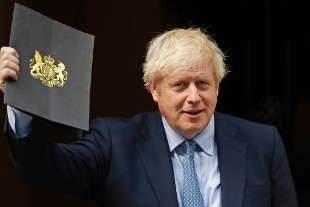- Brexit, it's hunting for votes. Boris Johnson to the 'Super Saturday'
- White smoke on Brexit, Juncker: "Agreement with London found"
Share
18 October 2019On 17 October - two weeks before the date set for the Brexit - the British government and the European Commission announced that they had found an agreement on the terms of the London exit from the EU. But the question is not closed. Now it will be necessary to approve both the EU - based on Article 50 of the TUE they must say yes both the European Council and the European Parliament - and of the United Kingdom.
According to media reports, there are uncertainties about the real possibility that the agreement now found by Boris Johnson could be approved in Westminster, in particular due to the opposition of Dup, the Northern Irish unionist party.
The former British premier, Theresa May, had failed three times - the last on March 29, 2019 - in an attempt to get the British MPs to approve the agreement she had found with the European Union.
Let's see what is different about the Johnson-based agreement and the one from May, in particular with regard to the Irish border and the so-called backstop .
This term refers to the Protocol on Ireland and Northern Ireland, as we will see later on, which creates a "safety net" to prevent the return of a physical border between Eire and Ulster, eliminated in 1999 thanks to the "Friday Agreements saint "signed the year before. The other points of the agreement, as reported by the European Commission, have in fact remained substantially unchanged.
From May to Johnson
In the agreement signed by Theresa May with the EU, and never ratified by the British Parliament, the Irish question had thus been resolved by the Protocol on Ireland and Northern Ireland: the United Kingdom would have remained (Article 6 of the Protocol) within a 'customs union with the rest of the European Union, until an agreement was found to avoid the return of a physical border between Northern Ireland and the Republic of Ireland at the end of the transitional phase after Brexit, ie by December 2020 ( unless extensions) . Potentially, therefore, the United Kingdom would have remained in the customs union for an indefinite time. The customs union, we specify, is an essential foundation of the EU. It means that there are no customs duties at internal borders between Member States, all goods circulate freely within the area of the customs union and the rules that are applied to customs for goods coming from outside the EU are uniform. In the May agreement, Northern Ireland would remain part not only of the customs union - with the rest of the United Kingdom - but also of the single European market (this would also happen with the Johnson agreement). This would have avoided the need for checks on goods passing from Ulster to the rest of Ireland. At that point, however, the United Kingdom should have imposed controls between Northern Ireland and the rest of its territories to control goods, people, capital and services entering and leaving the single market of which Ulster would have been a part. In fact, in order for there to be a single market, customs union is needed, but the single market is something more: inside it, goods, services, capital and people can freely circulate. The technical, legal and bureaucratic barriers that prevent this free movement have been eliminated in the European Union (with some exceptions).
Things change slightly in the Johnson agreement
The United Kingdom leaves the customs union altogether, and therefore - a fundamental consequence - it can freely conclude commercial agreements with third countries. Had he remained in the customs union, his freedom to sign such agreements would have been partially limited. For a period of at least five years, there will be a "legal" border between the two Irelands, but in practice the border will be in the Irish Sea, between Great Britain and Ireland. This is because, if the assets are considered "at risk" of entering Ireland, and therefore within the EU, they will be taxed, otherwise not (personal assets are excluded). The assets must therefore be checked upon their entry into Northern Ireland. On the question of which goods can be considered at risk and which will not be necessary for future agreements. Northern Ireland will remain aligned then, as already in the May agreement, with the standards on goods provided by the European Union (this too will therefore be subject to border controls that are created between Ulster and the rest of the United Kingdom ).
Four years after the end of the transitional period, so not before the end of 2024, the Ulster Parliament will be able to decide whether to renew these agreements or not. If he does it by simple majority there will be a renewal for four years. If specific majorities (both unionists and nationalists) are reached, the renewal will be eight years. If it does not renew them, there is a risk that the physical boundary between Irlande will return. Northern Ireland has also been without a government for two years, precisely because the Ulster Parliament is split and cannot find an agreement between Dup unionists and Sinn Fe'in nationalists.
Conclusion
The agreement found between the British executive, led by Boris Johnson, and the EU on Brexit has yet to be approved by the respective Parliaments and the European Council. The greatest risks of a non-approval by the British deputies are linked to the opposition of the Northern Irish unionist Dup. The backstop on Ireland has indeed changed compared to the one negotiated by Theresa May, but not much. The biggest difference is the UK's exit from the customs union in its entirety, which will allow London to freely negotiate trade agreements with third countries.

